Middle Rhine Valley
landscape of Rhine valley between Nahe mouth and Bonn
The Rhine Valley or Middle Rhine (German: Mittelrhein) is the most famous section of the Rhine, running between the cities of Bingen(near Mainz) and Bonn in Germany and spanning the states of North Rhine-Westphalia, Rhineland-Palatinate and Hesse. The section from Koblenz to Bingen, known as the Rhine Gorge, is a UNESCO World Heritage Site, and the entire valley is often called "The Romantic Rhine".
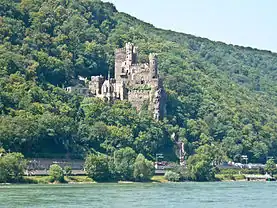
Cities
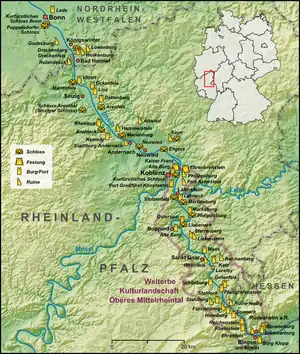
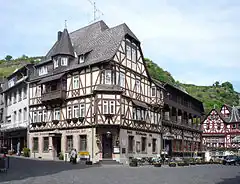
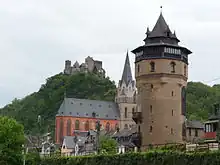
- 🌍 Bonn-Bad Godesberg (west), Cologne Lowland
- 🌍 Königswinter (east), Cologne Lowland
- 🌍 Bad Honnef (east), Cologne Lowland
- 🌍 Neuwied (east)
- 🌍 Bendorf (east)
- 🌍 Vallendar (east)
- 🌍 Koblenz (west) — where the Mosel river joins the Rhine
- 🌍 Lahnstein (east)
- 🌍 Braubach (east)
- 🌍 Boppard (west)
- 🌍 St. Goarshausen (east) — right across the river from St. Goar
- 🌍 St. Goar (west) — opposite the Loreley rock
- 🌍 Oberwesel (west)
- 🌍 Kaub (east)
- 🌍 Bacharach (west)
- 🌍 Lorch am Rhein (east), Rheingau
- 🌍 Trechtingshausen (west)
- 🌍 Assmannshausen (east), Rheingau
- 🌍 Bingen (west)
Understand
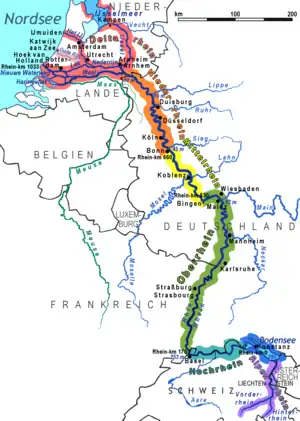
The Rhine Valley, where the Rhine carves its way through steep hills topped with countless castles and ruins, is one of the most famous and most heavily touristed parts of Germany. The travelling here is very easy — cruises, castles and vineyard tours by day, sampling local wines at night — so it's no surprise that visitors' demographics are slanted heavily towards retirees looking for an easy break.
For the more adventurous travellers, the Rheinsteig and Rheinburgenweg hiking trails along the hills surrounding the Rhine, each hundreds of km long, offer amazing vistas and access to the region's dozens of castles. A more leisurely option is to cycle the river banks to enjoy the vistas and the villages outside the boat and train stops.
When to go
The peak season is definitely summer, when the hillsides are green and the cruise boats busy. In September, many inns and restaurants already start closing down for the winter, and almost all cruises end by November, starting up again in April. The autumn paints many shades of orange and brown on the trees of the valley side, while the spring brings bright green and the white of tree blossoms.
Get in
The most common starting points for a tour of the Rhine Valley are Cologne, just north of Bonn, and Frankfurt, just east of Rüdesheim. Frankfurt is actually on the Main, not the Rhine itself, so the Rhine towns of Mainz and Wiesbaden also make popular starting points.
By plane
Frankfurt airport (FRA) is the major international airport for the area. Cologne/Bonn (CGN) has some connections from other European countries as does Hahn airport, which is the closest to the valley but without a car not so accessible.
By train
Bonn and Mainz, and with less service, Wiesbaden via Frankfurt are the key stations into the region. Bingen and Koblenz being the largest stations with Rüdesheim being a popular stop. Frankfurt airport has two stations: A regional station (Regionalbahnhof) with local and S train services to Frankfurt and Mainz, and a long-distance station (Fernbahnhof) with direct fast-train services to Mainz, Bingen (only some trains), Koblenz, Bonn, and Cologne.
By car
The A61 is just to the west of the Middle Rhine Valley. The A3 is a little further to the east of the valley.
By cruise
A large number of luxury cruise operators sail up (and down) the Rhine from Amsterdam to Basel, Zurich or Strasbourg or from the Rhine cruise up the Main and Danube to Budapest. The leisurely journey with plenty of stopovers typically takes anywhere from one to two weeks, with accommodation on the boat itself. Large operators include Avalon and Viking, with low-season prices for a 7-night cruise starting from around US$2,000.
Get around
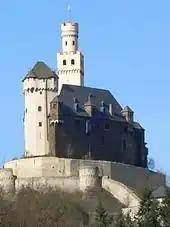
By car
Along the left bank runs the B9 ![]() while along the right bank the B42
while along the right bank the B42 ![]() runs the whole stretch of the valley. The majority of both roads in the Rhine valley section are one lane in both directions with few places to overtake. The roads are quite busy with tourists during the summer.
runs the whole stretch of the valley. The majority of both roads in the Rhine valley section are one lane in both directions with few places to overtake. The roads are quite busy with tourists during the summer.
On your travels you will want to visit locations on both sides of the river. Note that there are no bridges between Wiesbaden and Koblenz crossing the river but there are a number of ferries that take car, bike and foot passengers.
- Fähre Boppard. Ferry across the Rhine between Boppard and Filsen.
- Fähre Loreley. Ferry across the Rhine between Sankt Goar and St. Goarshausen.
- Fährgemeinschaft Kaub. Ferry across the Rhine between Bacharach / Oberwesel and Kaub.
- Mittelrhein Fähre. Ferry across the Rhine between Niederheimbach and Lorch.
- Bingen-Rüdesheim Auto-Ferry. From Bingen Harbour to just below Rüdesheim Bahnhof.
- Bingen-Rüdesheim Ferry. From Bingen Bridge 5 to just below Rüdesheim City.
- 🌍 Rheinfähre (A couple of kilometres from the Rheinsteig route.). A ferry across the Rhine from Ingelheim to Oestrich-Winkel.
By train
There are not one but two train lines running along this section of the Rhine:
- The Linke Rheinstrecke ("Left Rhine Line") runs along the left (west) bank of the river from Cologne (Köln) to Mainz, passing for example through Boppard, Sankt Goar, Oberwesel and Bacharach.
- The Rechte Rheinstrecke ("Right Rhine Line") runs along the right (east) bank of the river from Cologne to Wiesbaden, passing for example through Braubach, Kaub, Assmannshausen and Rüdesheim.
Both sides have Regional and InterCity services, but the Linke side also has Regional Express services which skip some stations. Train rides in the Rhine Gorge section can be quite scenic if you sit in the side of the train facing the river. Interchanging between the two is possible at Koblenz; alternatively, if you are staying in a town linked by a ferry service to the other side of the river, you may use the ferry to reach the line from the other side (for example Sankt Goar/Sankt Goarshausen, or Bingen/Rüdesheim).
The "core" of the Rhine Valley is in Rhineland-Pfalz's VRM and RNN tariff zone, the Rheingau stretch east of Lorch is also in Frankfurt's RMV zone, while going north of Remagen passes into Cologne's VRS area. But you can calculate the price of the journey and buy tickets using the Deutsche Bahn website or mobile app, which saves you the hassle of figuring out the different tariff zones. The same can be done using ticket machines or service counters (in the few stations they are available). Note that as of 2021, not all ticket machines accept credit cards, and some are not even able to provide change.
Some good offers to explore the surroundings include the Rheinland-Pfalz-Ticket, offering unlimited travel in local trains and buses for up to 5 persons inside the states of Rhineland-Palatinate, Saarland, Wiesbaden and Bonn("Left Rhine Line")for a day (9AM onwards on weekdays, all days weekends, up to 3AM of the following day). The ticket costs €24-44 per day (as of Dec. 2015) if bought via automat or internet, or €26-46 if bought at a ticket stand and is available at all train stations. In addition to the core stretch along the Rhine (Remagen-Oberwesel inclusive) and the train line along the Mosel, the ticket also covers a few handy train stretches outside state boundaries, notably Rolandseck-Bonn, Koblenz-Rüdesheim-Wiesbaden and Wiesbaden-Mainz.
By boat

The Köln-Düsseldorfer Rheinschiffahrt, better known as KD, runs cruises and scheduled services up and down the river between Cologne and Mainz. The summer season (May-Sept) sees up to 8 services daily on the busiest parts of the river, but services are cut considerably in the shoulder seasons of April and October and slow down to a trickle in the winter. Traveling end to end takes over 11 hours (€49 one way), so most travellers opt for much smaller segments: St. Goar to Bingen, for example, passes by the famous rock of Loreley, takes about 90 minutes and costs €15.30.
While KD has the most extensive network and schedules, there is quite a bit of competition. For example, Bingen-Rüdesheimer operates scheduled services on the south half between Rüdesheim and St. Goar and Roessler line cover the towns and castles in the south.
If you do not have time to do a full round tour consider taking the trip downstream (south to north), which is faster, and getting the train back to your start point).
On foot
- The Rheinsteig walking trail passes on the right Rhine side through (Wiesbaden), Rüdesheim, Lorch, Kaub, Braubach, Lahnstein, Koblenz-Ehrenbreitstein, Neuwied, Linz am Rhein, Bad Honnef and (Bonn).
- The Rheinburgenweg walking trail passes on the left Rhine side through Bingen, Bacharach, St. Goar, Boppard, Koblenz, Andernach, Ramagen and Rolandseck near Bonn-Mehlen.

See
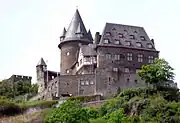
- 🌍 Loreley (above Sankt Goarshausen, opposite St. Goar). Large rocky outcrop on a bend in the Rhine river. Provides great views of the valley.
Castles
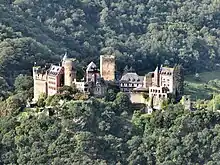
Driving or cruising along the valley there is nearly always at least two castles within sight. Many are open to the public but some are private or in ruins with no access. A few are hotels or hostels. The must visits are: Rheinstein, for its position and restored structure; the Marksburg for its well-preserved structure; and Rheinfels for its size and the chance to explore the underground areas (take a torch with you). Expect to do some steep climbing of stairs and walks along narrow high ramparts. Exciting and worth the visit but a little nerve racking with small children.
- Brömserburg Castle · Rüdesheim
- Boosenburg Castle · Rüdesheim
- Klopp Castle (Burg Klopp) · Bingen
- Mäuseturm (Toll Tower) · Bingen
- Ehrenfels Castle Ruin (Burgruine Ehrenfels) · Rüdesheim
- Rheinstein Castle · Trechtingshausen
- Reichenstein Castle · Trechtingshausen
- Sooneck Castle · Niederheimbach
- Heimburg Castle · Niederheimbach
- Fürstenberg Castle Ruins · Rheindiebach
- Stahleck Castle · Bacharach
- Stahlberg Castle Ruins · Bacharach-Steeg
- Pfalzgrafenstein Castle · Kaub
- Gutenfels Castle · Kaub
- Schönburg Castle · Oberwesel
- Katz Castle · St. Goarshausen
- Reichenberg Castle Ruins · Reichenberg
- Rheinfels Fortress (Festung Rheinfels) · St. Goar
- Maus Castle · Wellmich
- The Hostile Brothers - Sterrenberg Castle (ruin) (Feindliche Brüder) · Kamp-Bornhofen
- The Roman Camp in Boppard (Römisches Kastell)· Boppard
- Former Prince Electors' Castle in Boppard (Ehemalige Kurfürstliche Burg) · Boppard
- Osterspai Castle (Wasserburg Osterspai)· Osterspai
- Marksburg · Braubach
- Lahneck Castle · Lahnstein-Oberlahnstein
- Stolzenfels Palace (Schloss Stolzenfels) · Koblenz-Stolzenfels
- Prince Elector's Castle (Kurfürstliche Stadtburg) · Koblenz
- Electors' Palace (Kurfürstliches Schloss) · Koblenz
- Ehrenbreitstein Fortress (Festung Ehrenbreitstein) · Koblenz
Do

- Rheinsteig. Walk part of the trail on the right Rhine side.
- Rheinburgenweg. Walk part of the trail on the left Rhine side.
Events
- Rhein in Flammen (Rhine in Flames) Firework displays and lit-up cruise boats:
- Linz am Rhein - Bonn: Bonn. Early May. (date needs fixing)
- Rüdesheim - Bingen: Bingen. Early July. (date needs fixing)
- Spay - Koblenz: Koblenz. Mid-August. (date needs fixing)
- Oberwesel: Oberwesel. The "Night of a Thousand Fires" has been traditionally staged at Oberwesel. For this spectacle, 50 illuminated ships convoy to the town of St. Goar to watch the illumination of the legendary Loreley rock rising 300 feet out of the river. The procession will go from there upstream to Oberwesel passing towns, castles, and churches bathed in Bengal lights. The musical brilliant firework display in front of the medieval backdrop of Oberwesel is the highlight of the boat parade. Mid-September. (date needs fixing)
Eat
Drink
The Rhine Valley is famous for wine, and this section of the Rhine along with its tributaries the Mosel and Nahe cover 5 of Germany's 13 officially recognized wine regions. From north to south:
- Mosel: mostly sweet white Riesling, covers the entire Mosel River valley from Luxembourg to Koblenz
- Mittelrhein: almost all Riesling, from Koblenz to Bingen (left bank) and Königswinter to Kaub (right bank)
- Nahe: varies wines, along the Nahe river southwest of Bingen
- Rheingau: the best-known, almost all high-quality (Prädikat) Riesling, but Assmannshausen's red Spätburgunder (Pinot Noir) is also famous; right bank only, from Lorch via Assmannshausen, Rudesheim, Eltville, Wiesbaden to Hochheim am Main
- Rheinhessen: Germany's largest producer, along the left bank from Bingen through Mainz and south all the way to Worms
For those who enjoy a beer try Maximilians Brauwiesen micro-brewery in Lahnstein.
Stay safe
On the cruise ships there is not always shade on the decks, do not forget your sun cream and maybe sun hat.
Connect
Go next
- Bonn
- Bad Neuenahr-Ahrweiler
- Burg Eltz, near Treis-Karden on the Mosel
- Bad Kreuznach (Nahe)
- Ingelheim
- Mainz
- Rheingau
- Wiesbaden
- Moselle Valley
- Eifel